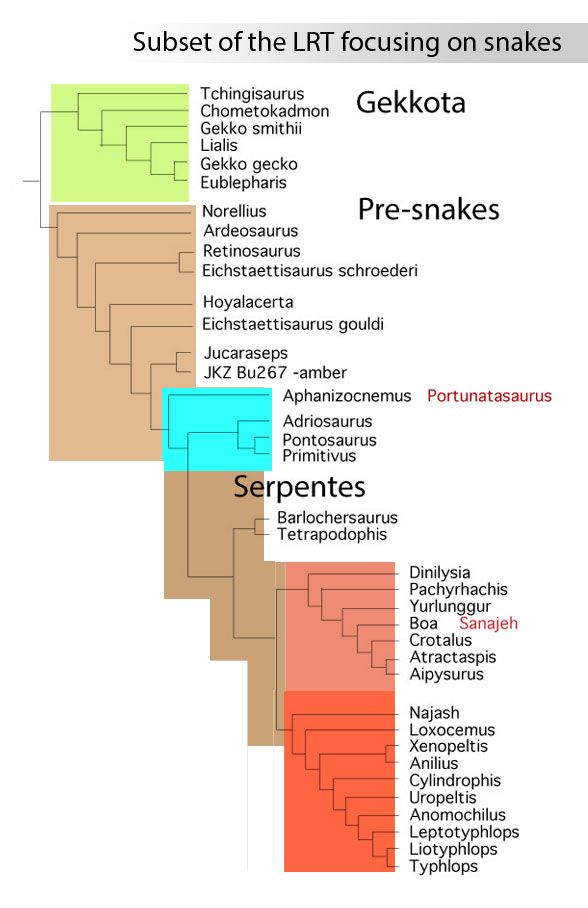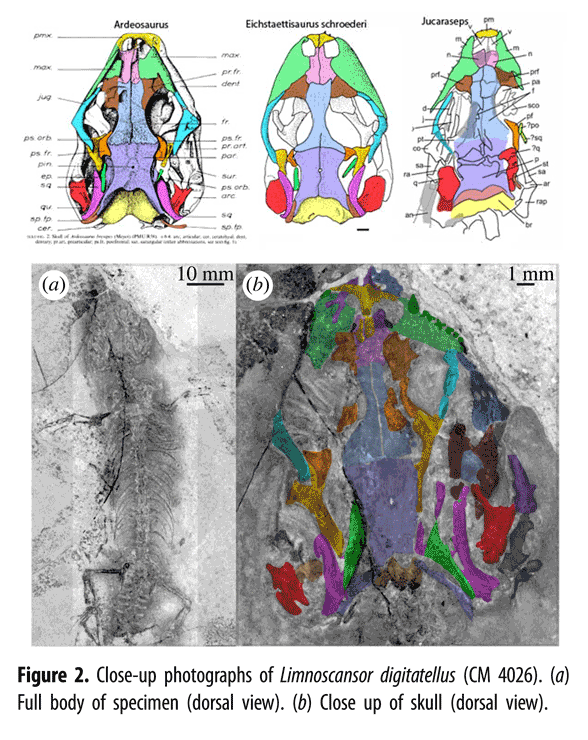Meyer et al 2023 described
“the first North American stem gekkotan based on a three-dimensionally preserved skull.” Another more complete, but crushed specimen (Limnoscansor Fig 2) was also included in this study. The Gauthier-led team also reported, “They are among the oldest divergences in the lizard crown, so understanding the origin of geckoes (Gekkota) is essential to understanding the origin of Squamata, the most species-rich extant tetrapod clade.”
According to the large reptile tree (LRT, 2037 taxa) gekkos are not essential to understanding the origin of Squamata, which is led by iguanids with immediate outgroups going back to the Permian (see Lacertulus and Saurosternon). By contrast gekkos ARE essential to understanding the origin of snakes (Fig 1), a result not recovered by Meyer et al, apparently due to taxon exclusion, discussed earlier when we looked at Gauthier er al 2012 in a 3-part series. The authors relied on that decade-old cladogram in this 2023 study.
Meyer et al wrote,
“To assess the phylogenetic affinity of Helioscopus dickersonae within Squamata, we used a modified version of the dataset of Gauthier et al. 2012, one of the largest and most comprehensive morphological analyses of squamates.”
In 2012 we looked critically at Gauthier et al 2012 in a three part series (links below).
In the cladogram of Meyer et al 2023
their two new taxa, Limnoscansor and Helioscopus, both nest with Ardeosaurus, while Schoenesmahl, Eichstaettisaurus and Norellius nest nearby at the base of their Pan-Gekkota.
Meanwhile, in the LRT
(Fig 1) other than the pre-squamate Schoenesmahl (formerly Bavarisaurus), all these taxa are not gekkos, but gekko-like pre-snakes ~ close to gekkos.
Another outgroup issue
These authors included Huehuecuetzpalli as a squamate outgroup, and it is one in the LRT. However this was a cherry-picked taxon (along with Sphenodon) – not a natural proximal outgroup recovered by a wide gamut analysis, like the LRT. The authors are unaware that Huehuecuetzpalli nests with Macrocnemus in the LRT (Peters 2007), not close to the origin of Squamata, but closer to Tanystropheus and pterosaurs.
Adding taxa will help the Gauthier team, but don’t hold your breath waiting for that to happen. It’s been a decade since Gauthier et al 2012 made their earlier mistakes without rectification.
I won’t be adding Limnoscansor and Helioscopus to the LRT.
The former appears to be very close to Ardeosaurus (Fig 2) and the latter is not represented by enough distinct material, despite being preserved in 3D and µCT scanned.
Gosh it feels good to get away from fish systematics for at least one post every so often.
References
Gauthier JA, Kearney M, Maisano JA, Rieppel O and Behlke ADB 2012. Assembling the squamate tree of life: perspectives from the phenotype and the fossil record. Bull. Peabody Mus. Nat. Hist. 53, 3–308.(doi:10.3374/014.053.0101)
Meyer D, Brownstein CD, Jenkins KM, Gauthier JA 2023. A Morrison stem gekkotan reveals gecko evolution and Jurassic biogeography. Proc. R. Soc. B 290: 20232284.
https://doi.org/10.1098/rspb.2023.2284
Peters D 2007. The origin and radiation of the Pterosauria. In D. Hone ed. Flugsaurier. The Wellnhofer pterosaur meeting, 2007, Munich, Germany. p. 27.



This is really interesting. Geckos have long been so difficult to place on the squamate tree and perhaps this provides a solution. Are you aware of the extinct genus of supposed pan-gecko called Suganda by chance?
I have not heard of “Suganda” gekko. Googling it does not seem to help. All I get is another genus. If you can provide a citation title?
Absolutely!
Tinglé, C. 2019. A new species of fossil gecko, †Suganda bofa, from the Late Jurassic of northern Germany. Proceedings of the East Netherlands Institute of Science 12:47-60.